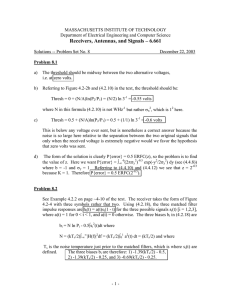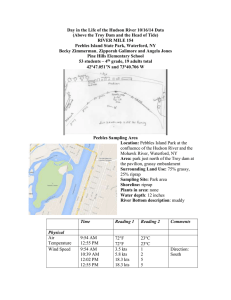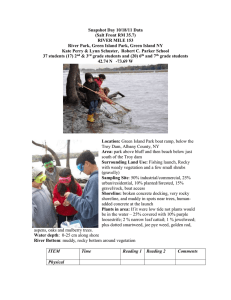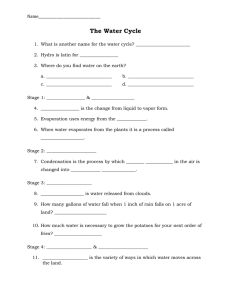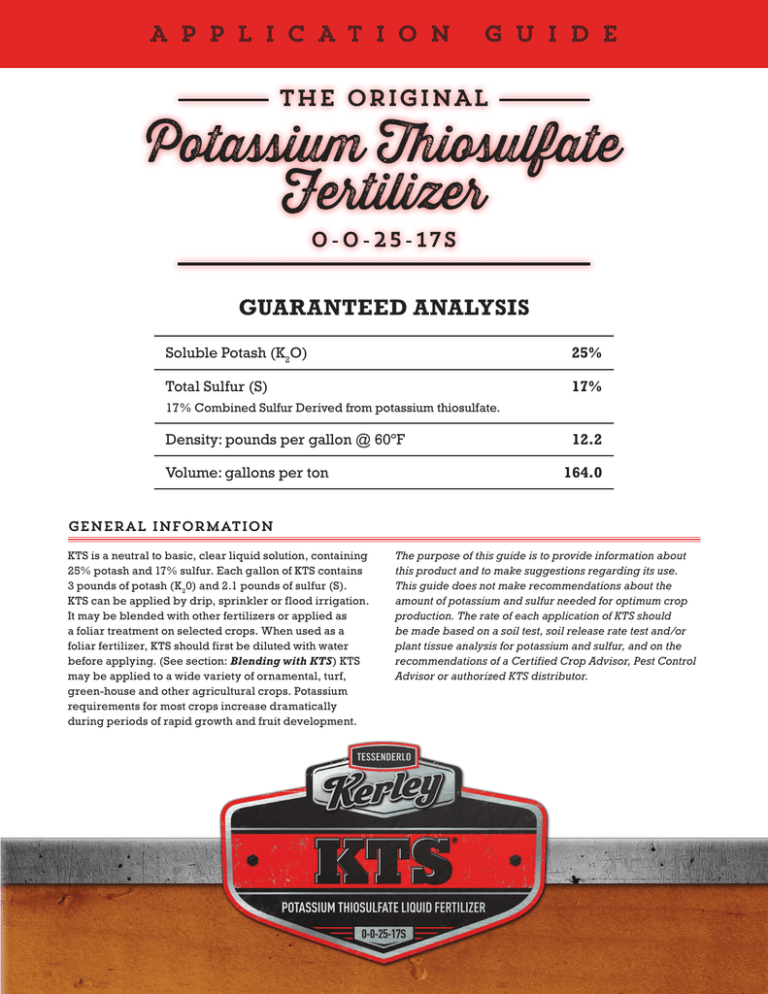
A P P L I C A T I O N
G U I D E
THE ORIGINAL
Potassium Thiosulfate
Fertilizer
0-0-25-17S
GUARANTEED ANALYSIS
Soluble Potash (K2O)
25%
Total Sulfur (S)
17%
17% Combined Sulfur Derived from potassium thiosulfate.
Density: pounds per gallon @ 60ºF
Volume: gallons per ton
12.2
164.0
General Information
KTS is a neutral to basic, clear liquid solution, containing
25% potash and 17% sulfur. Each gallon of KTS contains
3 pounds of potash (K 20) and 2.1 pounds of sulfur (S).
KTS can be applied by drip, sprinkler or flood irrigation.
It may be blended with other fertilizers or applied as
a foliar treatment on selected crops. When used as a
foliar fertilizer, KTS should first be diluted with water
before applying. (See section: Blending with KTS) KTS
may be applied to a wide variety of ornamental, turf,
green-house and other agricultural crops. Potassium
requirements for most crops increase dramatically
during periods of rapid growth and fruit development.
The purpose of this guide is to provide information about
this product and to make suggestions regarding its use.
This guide does not make recommendations about the
amount of potassium and sulfur needed for optimum crop
production. The rate of each application of KTS should
be made based on a soil test, soil release rate test and/or
plant tissue analysis for potassium and sulfur, and on the
recommendations of a Certified Crop Advisor, Pest Control
Advisor or authorized KTS distributor.
— Page 2 of 6 —
Soil Application
STARTER FERTILIZER
Be sure to follow established recommendations for
crop, soil type and moisture conditions in your area.
Excessive amounts of fertilizer can damage seed
germination. Do not apply KTS directly on the seed
of legumes or other small seeded crops. Do not
exceed established recommendations for N + P + K
for local soil type and conditions.
Starter recommendations are for a 2"x 2" (2 inches to
the side and 2 inches below the seed) or a 2"x 0" (2
inches to the side of the seed on the soil surface).
Corn: 1 to 4 gallons of KTS per acre by itself or with
other starter fertilizers.
Wheat: 1 to 4 gallons per acre by itself or with other
starter fertilizers.
POP-UP FERTILIZER (IN-FURROW)
Corn: 2 to 4 quarts of KTS per acre by itself or with
other liquid pop-up fertilizers, based on 30" rows.
Wheat: 2 to 4 quarts of KTS per acre by itself or with
other liquid fertilizers, based on 15" rows.
SIDEDRESS APPLICATION
KTS can be soil injected or deep banded by itself
or with nitrogen and phosphorus to supply crops
with N, P, K and S requirements for the season.
Soil injection can improve nutrient use efficiency
by reducing nutrient loss due to erosion and soil
fixation. KTS can also be broadcast sprayed on soil
surface or surface banded midway between rows
to help meet potassium and sulfur requirements.
Follow soil and tissue analysis recommendations to
apply the proper amount of potassium and sulfur.
Corn, Cotton, Soybeans: 3 to 15 gallons per acre
soil injection on medium to fine textured soils and 3
to 10 gallons per acre on sandy soils; avoid pruning
roots. Apply as needed to meet crop requirements.
For surface banding or dribble application, 3 to 10
gallons per acre on medium to fine textured soils
and 3 to 5 gallons per acre on sandy soils. Do not
allow spray or spray drift to contact leaves, stalks or
any part of the crop due to potential phytotoxicity.
Vegetables: 3 to 12 gallons per acre soil injection
on medium to fine textured soils and 3 to 8 gallons
per acre on sandy soils; avoid pruning roots. Apply
as needed to meet crop requirements. For surface
banding or dribble application, 3 to 12 gallons per
acre on medium to fine textured soils and 3 to 8
gallons per acre on sandy soils. Do not allow spray
or spray drift to contact leaves, stalks or any part of
the crop due to potential phytotoxicity.
Rates will vary depending on crop requirement and
soil analysis.
Foliar Fertilizer Application
Suggested application rates for certain crops are
listed. For crops not listed in this document, contact
your local fluid fertilizer dealer or your Tessenderlo
Kerley representative. KTS may be applied by
ground or air. It is recommended that the addition of
2 to 4 quarts of TRISERT-NB® (26-0-0), TRISERT-CB®
(26-0-0-0.5B) or N-SURE® (28-0-0) be applied with
the KTS. TRISERT-CB, TRISERT-NB and N-SURE are
Tessenderlo Kerley's triazone based slow-release
liquid nitrogen fertilizers that improve the foliar
absorption of KTS.
Do not apply KTS to the foliage of any crop when
temperatures are, or will be, above 90º F. Apply
early in the morning or late evening.
Cotton: 4 to 5 quarts per acre beginning from the
1st through to the 4th week of bloom along with 2
quarts/acre of N-Sure.
Potatoes: 2 to 4 quarts per acre beginning at tuber
initiation; apply second treatment at golf ball size
and third treatment at tuber bulking.
Small Grains: 2 to 8 quarts per acre at tillering to
early boot stage.
Canola: 2 to 8 quarts per acre at bolting.
Alfalfa: 4 to 8 quarts per acre at crown green up or
on regrowth just after cutting.
Rice: 4 to 6 quarts per acre at panicle initiation.
Peas and Lentils: 2 to 4 quarts per acre during late
bud to 10% bloom.
Tomatoes: Begin at fruit set; apply 2 to 4 quarts per
acre every 7 to 14 days.
Soybeans: 4 to 6 quarts per acre at R1 to R2 stage.
Sugar Beets: 1 to 2 gallons per acre at bloom.
Wheat: 2 to 8 quarts per acre at tillering to early
boot stage.
— Page 3 of 6 —
Enhance Crop Quality
with Immediately available Potassium and SUlfur
Apples, Apricots, Almonds, Citrus, Pecans:
KTS at 2 to 6 quarts per acre in a minimum of 100
gallons of water spray solution. Begin application
at first full leaf and apply as needed during the
growing season. For concentrated sprays of less
than 100 gallons per acre, reduce the rate of KTS to
stay within the recommended solution ratio (i.e., 50
gallons of water per acre equals 1 to 3 quarts of KTS
per acre).
All rates listed are for established crops on
medium to fine textured soils (suggested rates
are for trees and vines at least 4 years old or
older). Avoid application to new plantings
until crop is well established. For sandy
soils, suggested rates should be reduced
by 50%. Do not apply KTS when crops are
experiencing heat or moisture stress.
Viniferous Vines: Begin 2 weeks after bloom: 2 to 4
quarts per acre in a minimum of 50 gallons of water.
Repeat treatment in 7 to 10 days. Do not apply foliar
to Concord grapes.
FLOOD AND FURROW IRRIGATION
Recommendations listed above are for KTS and
TRISERT application only. The addition of other
products to the spray mix is the responsibility of the
applicator and not TKI, and should be tested on the
crop in a small area before applying to large areas due
to possible phytotoxicity. Avoid using silicon adjuvants
when applying KTS in a foliar spray.
Vegetable and Row Crops: 5 to 10 gallons per acre
per application; apply once every 2 to 3 weeks.
Fertigation
Trees and Vines: 5 to 12 gallons per acre per
application; apply once every 2 to 3 weeks starting
at full leaf.
sPRINKLER/CENTER PIVOT
IRRIGATION
Fertigation is the practice of injecting soluble
fertilizers through irrigation systems using water as
a nutrient delivery system to the crop.
Trees (Under): 5 to 8 gallons per acre per
application every 10 to 14 days based on crop
requirements.
Before injecting KTS into an irrigation system, make
sure that the irrigation system is in good condition
and provides uniform distribution to the field.
Application of nutrients like KTS should be made in
the middle third or second half of an irrigation set.
Several hours of irrigation should take place before
and after the injection of KTS.
Trees (Overhead): 3 to 5 gallons per acre every 10
to 14 days based on crop requirements.
The injection of KTS should be done slowly, and should
last at least as long as it takes irrigation water to travel
from the point of injection to the last emitter or sprinkler
in the field. The injection of KTS should be done with a
fertilizer injection pump and should be done over a 1
to 4 hour time period. Rapid injection of KTS may lead
to uneven distribution of the KTS and may cause crop
damage. For additional information about injection of
nutrients into an irrigation system, consult with your
local agronomist and review University of California
publication 21620 “Fertigation with Microirrigation,”
or University of Florida Bulletin #250 “Injection of
Chemicals Into Irrigation Systems: Rates, Volumes, and
Injection Periods.”
Vines: 3 to 5 gallons per acre every 10 to 14 days
based on crop requirements.
Vegetable and Row Crops: Beginning at the 3rd 4th leaf stage, apply 1 to 6 gallons per acre every 7
to 10 days based on crop requirements.
After injection, allow enough irrigation time (at least 60
minutes) to rinse the plants of any residual fertilizer.
— Page 4 of 6 —
Drip irrigation
Blending with KTS
Young Trees: 3 to 5 gallons per acre during the
season, starting at full leaf; apply once every 3 to 4
weeks.
KTS is compatible with liquid urea and ammonium
polyphosphate (APP) solutions in any ratio.
Mature Trees: 5 to 10 gallons per acre, starting at
full leaf; apply once every 3 to 4 weeks.
Grapes: Application of KTS can be made any time
up to veraison and post-harvest.
Young vines: 3 to 5 gallons per acre, no more
than once every 3 to 4 weeks.
Mature vines: 5 to 10 gallons per acre as
required according to tissue analysis, no more
than once every 2 weeks.
Vegetable and Row Crops: 3 to 5 gallons per acre,
once every 10 days, no more than 3 times per month.
Strawberries: 3 to 5 gallons per acre once every 10
days after plants are well established, no more than
3 times per month.
Blueberries: 3 to 5 gallons per acre once every 10
days after plants are well established, no more than
3 times per month.
Cane berries: 3 to 5 gallons per acre once every 10
days after plants are well established, no more than
3 times per month.
MICRO-SPRINKLER (FAN JET)
When blending KTS and UAN solution, as much
water, by weight, should be added to the blend to
equal the amount of KTS or UAN in the final mix.
Blending order should be: KTS, then water, followed
by UAN. Blends with UAN solution should be tested
first before making large quantities. In cold weather,
the potassium in KTS reacts with the nitrate in UAN
to form potassium nitrate crystals. Adding water or
heat will bring the crystals back into solution. Avoid
sparging air into KTS or a KTS blend. When mixing
pesticides with KTS, and other fertilizers, the blend
sequence should be as follows: water, then pesticide,
followed by KTS and/or other fertilizer. Always make
sure that combinations with pesticides are compatible.
Micronutrient blends should be jar tested first before
mixing with KTS. In most situations, micronutrients
have to be chelated to a neutral pH. Strongly acidic
and/or weak chelates do not blend well with KTS.
Blends of KTS should not be acidified below a pH of
6.0.
SOME EXAMPLES OF STARTER
FERTILIZERS BLENDS
BLEND
Young Trees: 3 to 5 gallons per acre, once every 3
to 4 weeks.
Mature Trees: 6 to 12 gallons per acre, once every
3 to 4 weeks.
6-21-6-4S
Young Vines: 3 to 5 gallons per acre, once every 3
to 4 weeks, starting at full leaf.
Mature Vines: 5 to 10 gallons per acre as required
according to tissue analysis, once every 3 to 4 weeks
starting at full leaf.
7-25-6-4S
10-13-5-3S
PRODUCTS
POUNDS PER
TON
10-34-0
1235
KTS
480
Water
285
10-34-0
1470
KTS
480
Water
50
UAN 32
388
10-34-0
765
KTS
400
Water
447
Always do a jar test before making large quantities.
When blending KTS and UAN 32, always have as much
water, by weight, in the blend as either one of these
products.
— Page 5 of 6
pH AND CROP PRODUCTIVITY
•Do not apply KTS while chlorinating irrigation
system. Thiosulfates will neutralize chlorine.
Soil pH has a direct effect on nutrient availability
as well as soil microbial activity. A low soil pH can
indicate the presence of high levels of toxic ions such
as manganese, iron and/or aluminum while a high
pH can indicate the presence of free lime in the soil.
Most crops do best with a soil pH between 6.0 and 7.5
for optimum nutrient uptake.
•Do not mix KTS with acid or acidic fertilizers below
a pH of 6.0. KTS will decompose.
Periodic testing of soils is the only way to determine
soil pH and the appropriate course of action to
maintain soils at their full productive potential.
Minimize or avoid applications of KTS if the pH of the
soil is below 6.0.
Precautionary Statements
•Recommendations are for KTS only; the addition
of other fertilizers at or near the same time could
increase the chance of phytotoxicity to the crop.
Please allow several days between injections.
•When mixing KTS or any liquid fertilizer with
pesticides always keep agitators running during
filling and spraying operations. Failure to maintain
agitation may cause separation of products
resulting in uneven spray application.
•Many crops are sensitive to salts during
germination. When soil moisture is low, delayed
crop emergence and/or phytotoxicity may occur
when fertilizer is placed too close to the seed. Do
not use KTS in pop-up fertilizer when soil moisture
is limited, soil salinity is above an electrical
conductivity of 1.0 or when irrigation is delayed
such that germination may be affected.
For information on safety and handling, consult a
Safety Data Sheet (SDS) or visit our website at: www.
cropvitality.com.
CAUTION: Plant and leaf injury may occur on some
crops when certain weather and growing conditions
are present. The user assumes all risks of use and
handling.
•Do not apply KTS to foliage of crops sensitive (foliar
burn) to sulfur
•Do not apply KTS to foliage of any crop when
temperatures are, or will be, above 90º F. Apply
KTS in the early morning or late evening.
•Fertigation application of KTS and other liquid
fertilizers to an established crop may cause injury
to a crop if:
•injection period is less than 60 minutes, which
may cause an uneven distribution of KTS to the
crop
•Use caution when applying fertilizer to crops
experiencing heat or moisture stress. Fertilizers
are salts which compete with the crop for water.
Crops should be hydrated before applying any
fertilizer.
•KTS rates are higher than suggested
•ample irrigation water is not applied immediately
before and after the injection of KTS
•The total rate of fertilizer applied should be split
among several irrigations at lower rates per
application as temperatures increase.
•Do not apply KTS with knife injectors or other types
of fertilizer injecting equipment that may cause root
pruning.
•Do not apply KTS foliar with crop oil sprays. Allow
at least 14 days before or after an application of
crop oil before applying KTS as a foliar.
•Do not use high-pressure sprays (greater than 60
psi) when applying KTS over the top of a crop.
•Crop injury may result from unusual weather
conditions (heat wave, drought, or hot drying
wind), or improper application practices such as
injecting fertilizer to quickly all of which are out of
control of the manufacturer or seller. For further
information contact a Certified Crop Advisor
(CCA), Pest Control Advisor (PCA), fertilizer dealer
or Crop Vitality Specialist.
Keep out of reach of children. Use caution when handling.
See SDS for additional information on
safety and handling at: cropvitality.com/kts
Technical Data
Information
KTS
0-0-25-17S
Plant Nutrient Content Wt. %
Soluble Potash (K2O)
25.00
Total Sulfur (S)
17.00
Typical Properties
Specific Gravity
pH
Appearance
Salting-Out Temperature
1.46
7.00 to 8.20
Clear, Colorless
ºF <15.00
Formulation and Application Factors 60ºF
Density pounds per gallon
Volume gallons per ton
12.20
164.00
Tessenderlo Kerley, Inc. warrants only that this
product conforms to the product description on the
application guide. Tessenderlo Kerley, Inc. makes
no representation or warranty or guarantee, whether
expressed or implied, disclaims any warranty of
fitness for a particular purpose of merchantability,
or of product performance. Tessenderlo Kerley,
Inc. does not authorize any agent or representative
to make any such representation, warranty or
guarantee. Tessenderlo Kerley, Inc.’s maximum
liability for breach of its warranty or for use of this
product, regardless of the form of action, shall not
exceed the purchase price of this product. Buyer and
user acknowledge and assume all risks and disposal
liability resulting from handling, storage, use and
disposal of this product, whether in accordance with
directions or not. If buyer does not agree with or
accept these warranty and liability limitations, buyer
may return the unopened container to the place of
purchase for full refund. Some states do not allow
the exclusion of implied warranties or the limitation
of certain damages, so the above may not apply.
The purchase, delivery, acceptance and use of this
product by the buyer are subject to the terms and
conditions of seller’s sales invoice for this product.
©2011, 2013, 2014, 2015 Tessenderlo Kerley, Inc. All
rights reserved. This material is protected by the
copyright laws of the United States and international
treaties. Use, copying, reproduction, distribution,
display or transmission in any form by any means,
without the express written permission of Tessenderlo
Kerley, Inc. is prohibited and may result in civil and
criminal liability.
Contact Information
Tessenderlo Kerley, Inc.
2255 North 44th Street, Suite 300 | Phoenix, AZ 85008
Telephone: 602-889-8300 | Toll-Free: 800-525-2803
email: kts@cropvitality.com | cropvitality.com
KTS ® is a registered trademark of Tessenderlo Kerley, Inc. Revised: 08/2015

